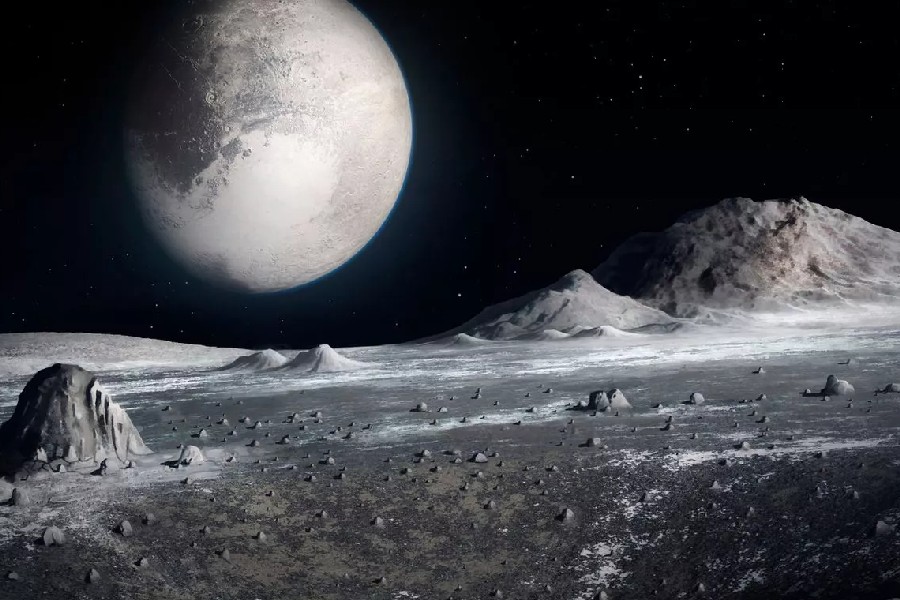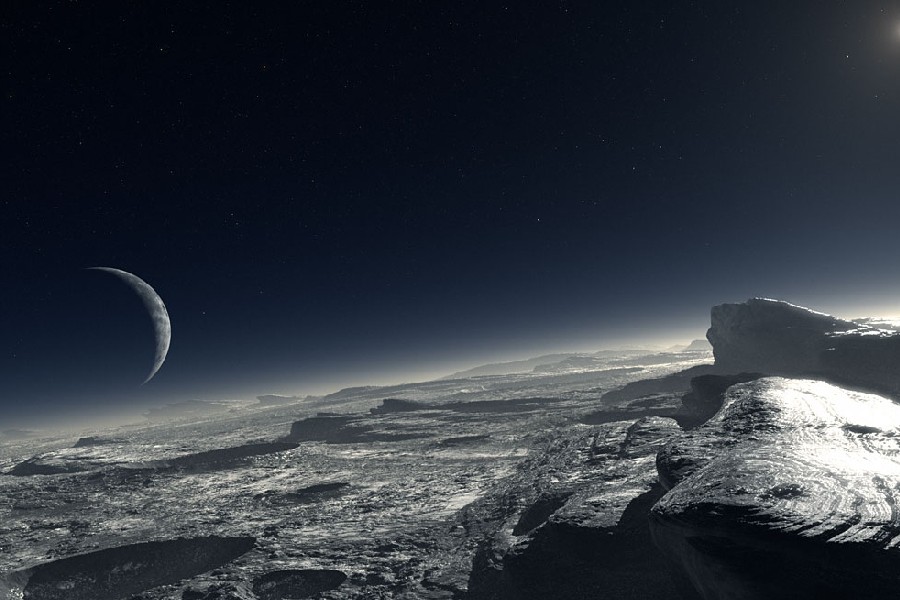Tiny Pluto harbors big mysteries that surprise scientists, given its small size. One major puzzle surrounds the question of whether frigid little Pluto can have an atmosphere. We’ve always imagined what life on other planets would look like. What would happen if there’s just a slight breath of possibility for potential for life? So, does Pluto have an atmosphere?
If so, what gasses could stick around this cold, distant world? Does Pluto gain and lose atmosphere as it travels on its long, stretched orbit? There’re many answered questions, exactly why we’ll do our best to resolve any doubts you have regarding this controversial, now dwarf planet.
As we explore what thin air – if any – surrounds petite Pluto, more insights around atmosphere behavior in the outer solar system may emerge. Read on to discover what we know about the atmosphere encircling one of our solar system’s most fascinating worlds.
Does Pluto Have an Atmosphere?
Pluto does have an atmosphere, but it’s extremely thin compared to Earth’s. It’s mostly composed of nitrogen, with traces of methane and carbon monoxide.
Pluto’s atmosphere is so sparse that standing on its surface, you wouldn’t feel it. It lacks the density of Earth’s air, making it quite different. In essence, while Pluto does have some surrounding gases, unfortunately, they are not substantial enough to resemble the atmosphere we experience on our home planet.

The History of Pluto and Its Atmosphere
Historical context
Pluto was discovered in 1930 by Clyde Tombaugh. But, early telescopes could not confirm an atmosphere as Pluto appeared only as a faint dot of light. Luckily, with the improvement in technology, evidence emerged for a thin atmospheric haze.
Spectroscopy in the 1980s hinted at methane and nitrogen air. The arrival of the New Horizons spacecraft in 2015 finally provided detailed atmospheric data, helping scientists understand Pluto’s air better.
This technological leap allowed us to confirm not just the existence but also the intriguing details of Pluto’s atmosphere, showcasing the remarkable progress in our exploration of the distant icy dwarf planet.
Early observations
In the decades after Pluto’s discovery, some observations suggested an atmosphere. In 1953, Gerard Kuiper detected evidence of methane-air. However, observations were limited at the time.
While an atmosphere was proposed, its properties remained elusive. It took advances in telescopes and cameras to gather more concrete evidence over the later 20th century.
This paved the way for New Horizons’ landmark flyby, offering a close-up look at Pluto and finally unlocking the secrets of its atmosphere, providing scientists with invaluable data to enhance our understanding of this distant celestial body.
Characteristics of the Atmosphere of Pluto
Composition & structure
Pluto’s atmosphere consists of nitrogen, methane, and carbon monoxide, with nitrogen dominating at about 98%. Methane and carbon monoxide are present in smaller amounts.
The atmosphere features distinct layers, encompassing a troposphere and thermosphere, extending roughly 1,000 to 1,500 km above the surface. Pluto’s frigid temperatures trap atmospheric molecules close to the ground, creating a unique environment.
The thinness of the atmosphere, with surface pressures 100,000 times less than Earth’s, highlights the vast differences between Pluto and our home planet, showcasing the fascinating variety of atmospheres within our solar system.
Many of us are interested in learning more about Pluto’s structure besides the solids found. Does Pluto have clouds? Scientists may have spotted more than half a dozen clouds in the planet’s hazy atmosphere. So, if there are potential clouds, does Pluto have storms? There’s a high chance that Pluto has clouds and storms because it has a bigger atmosphere than Triton, and clouds and winds have been observed above Triton.
Temperature and Pressure Variations
Pluto’s atmosphere experiences dramatic swings in pressure and temperature. Surface atmospheric pressure can vary from 20 to 60 microbars. Based on thorough research, scientists found that Pluto’s temperature is -387°F (-232 °C), which is too cold to sustain any life. Life as we know it show it’s unlikely to have life on the planet.
These fluctuations in temperature relate to Pluto’s eccentric orbit around the Sun. Heat from the distant Sun drives the temperature and pressure changes. The atmosphere partially collapses and reforms during each orbit around the Sun. The closer Pluto orbits around the sun, the warmth from the Sun heats up the icy nitrogen, methane, and carbon monoxide on the surface. When further away from the Sun, the atmosphere freezes and falls on Pluto’s surface.
These dynamic variations are influenced by Pluto’s elliptical path. They showcase the planet’s resilience as it responds to the Sun’s influence. This offers a unique perspective on the intricate dance between celestial bodies and their atmospheres in our solar system.

Sources and Sinks for Gas Species in Its Atmosphere
Gas species origins
Pluto’s atmosphere draws its nitrogen and carbon monoxide primarily from the icy expanse of its surface. This intriguing relationship unfolds as Pluto traverses its orbital path. Pluto experiences fluctuations in temperature that prompt the sublimation of surface ice. This enriches the atmosphere with nitrogen and carbon monoxide.
The origin story of methane adds an additional layer of complexity. Methane emerges from chemical reactions between atmospheric nitrogen and hydrogen. Beyond these processes, the inner moons contribute to the methane inventory. They do this through the ejection of ice particles in a celestial choreography.
Furthermore, the transformative role of ultraviolet light comes into play. This cosmic force interacts with methane, converting it into heavier hydrocarbons known as tholins.
These tholins, like organic tar, create a distinctive coating on Pluto’s surface, embodying the intricate interplay between the celestial body and its atmosphere.
Sinks and losses
Pluto’s atmospheric gases face a series of intricate processes leading to their loss. Temperature fluctuations induce the condensation and freezing of gases back onto Pluto’s surface, acting as a natural sink for methane and carbon monoxide.
Moreover, the relentless influence of solar wind gradually strips away the lighter gases. In this complex interplay, escaping molecules become ionized and are carried away into the vastness of space.
The nuances of Pluto’s weak gravity become apparent as Jean’s escape and hydrodynamic escape mechanisms operate, causing periodic collapses in the atmosphere.
This phenomenon occurs during the section of Pluto’s orbit farthest from the Sun, showcasing the delicate equilibrium between the celestial body and its tenuous envelope.
Impact on Atmospheric Circulation Patterns
Influence on circulation
Pluto’s atmosphere, despite being very thin, has a big job in shaping its weather. The gases in the air, like nitrogen and methane, act like the planet’s “weather ingredients.”
When these gases absorb sunlight on the sunny side of Pluto they create upward movements in the air, much like bubbles in a fizzy drink. As the colder, heavier air moves towards the darker night side, it generates winds.
These winds, blowing at a few meters per second, influence the planet’s weather patterns. Additionally, when it gets chilly on Pluto’s night side, a misty haze forms due to the unique composition of the atmosphere.
This interplay of factors showcases the fascinating dynamics of Pluto’s atmosphere. This reveals a connection between its composition, sunlight, and the intriguing dance between day and night on this distant celestial body.
Conclusion
In wrapping up, we’ve explored Pluto’s thin but important atmosphere. So, does Pluto have an atmosphere? Yes, but not enough to sustain life! We’ve learned about the special gases like nitrogen and methane that make up its air.
When these gases soak up sunlight, they create movements in the air, making winds and fascinating circulation patterns. This article aimed to help you understand this unique dance happening in Pluto’s atmosphere.
We hope you now see how Pluto’s thin air plays a big role in shaping its weather. As we keep learning about the wonders of space, may this peek into Pluto’s atmosphere spark your curiosity about the amazing things happening in our solar system.
